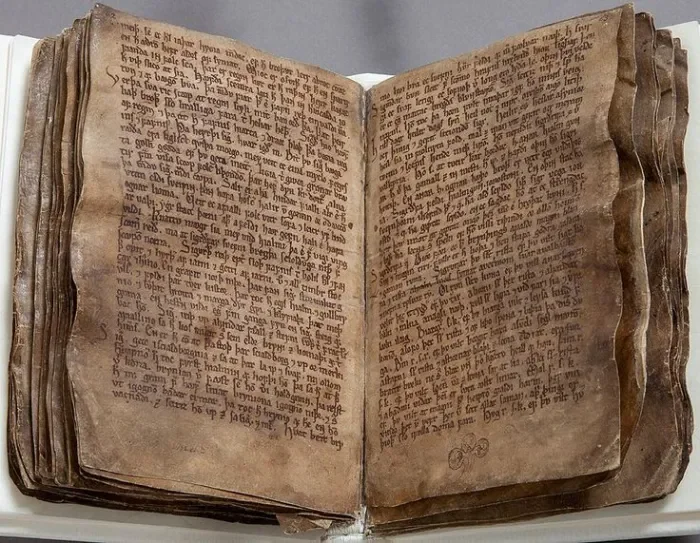
The Great Heathen Army: The Storm of the North
In 865 AD, the seas delivered not a raid but a reckoning. The Great Heathen Army (jarls and war-bands from Denmark, Norway, and Sweden) came to Britain with vengeance, conquest, and settlement in mind. Led in saga and song by the sons of Ragnar Lothbrok (Ívarr hinn Beinlausi, Halfdan, and Ubba) the host shattered kingdoms, captured York, carved the Danelaw, and forced Alfred of Wessex to forge unity from ruin. Shield walls crashed, wedges split ranks, and longships turned rivers into roads. From Repton’s graves to Jórvík’s markets, conquest hardened into culture: Old Norse mingled with Old English; law, language, and place-names took root. The storm met its check at Edington, where Guthrum bent to baptism and a new border was drawn. Yet the legacy endured (coins, courts, and words in the tongue) evidence that the invasion remade the island. This is the story of a tempest that did not just ravage England - it helped create it.

Flateyjarbók: The Book of Flatey
Hidden away for centuries on the island of Flatey, Flateyjarbók is the largest and most beautiful of all Icelandic manuscripts. Written between 1387 and 1394, it gathers the sagas of kings, saints, and explorers — including the only surviving stories of Norse voyages to North America. More than just a book, it is a record of how medieval Icelanders saw their history, faith, and the world around them.

Hervor: The Maiden Of The Dead Flame
She called to the dead and they answered in fire. In the age of iron and storm, one name echoed across the North like a battle cry: Hervor, the Viking shieldmaiden born of doom and destiny. She defied fate, summoned spirits from their graves, and claimed the cursed sword Tyrfing beneath a sky of haunted flame. Hers is a tale of fire, fury, and fearless will - the saga of a warrior who carved her own fate with steel. This is not just legend. This is Hervor: The Maiden of the Dead Flame.

Erik the Red: The Outlaw Who Forged a World from Exile
In the old North, where fire met ice and exile was often a death sentence, one man turned banishment into legend. Erik the Red, the fierce and fiery outlaw, was cast out of every land he called home - yet he built one of his own. From Norway to Iceland and finally to Greenland, Erik’s fury became his fire, his exile became his forge, and from both he created a world that would outlast his name.
His story is not only one of discovery and defiance, but of vision, endurance, and the unbreakable will of a man who refused to kneel before fate. In his saga lies a timeless truth — that even in exile, the spirit of creation burns brightest.

Ragnar Lothbrok: The Viking Who Became Legend
Ragnar Lothbrok, the Viking who became legend, straddles the line between history and myth. Feared raider, cunning strategist, lover of shieldmaidens, and the man who laughed in a pit of serpents — Ragnar’s story is as much saga as it is legacy. His sons carried his name across Europe, but it is Ragnar’s fearless defiance of fate that keeps his legend alive today. Was he a real man, or a myth made flesh?

Ivar the Boneless – Defiance Carved in Flesh
Born with a body too fragile for war, yet remembered as one of the fiercest Viking leaders in history, Ivar the Boneless defied every limitation. Carried into battle where others marched, he commanded armies, toppled kings, and carved a legacy of fear and brilliance that reshaped the Viking Age. His story, caught between legend and history, is a reminder that true strength lies not in bone and muscle, but in unbreakable will.

The Great Lacuna - The missing texts of the Poetic Edda
The Codex Regius is the single most important manuscript of Norse mythology—but it carries a haunting mystery at its core. Eight leaves are missing from its heroic section, a gap known as the Great Lacuna. This loss strikes at the very heart of the Sigurðr–Brynhildr tragedy, erasing the poetic account of love, betrayal, and death that once stood alongside the greatest epics of world literature. What remains are fragments and echoes: prose sagas, later German adaptations, and the faint outlines of poems now gone. This blog explores what was lost, what scholars believe the lacuna once contained, and why it matters so deeply for our understanding of the medieval Norse imagination.

The Codex Regius - Poetic Edda
The Codex Regius is more than a medieval manuscript—it is the beating heart of Norse mythology. Written in Iceland around 1270, this fragile book preserves the Poetic Edda, the only complete collection of ancient mythological and heroic poems that tell of Odin’s wisdom, Thor’s hammer, Sigurd the dragon-slayer, and the doom of Ragnarök. Lost for centuries and rediscovered in 1643, the Codex travelled to Denmark and was only returned to Iceland in 1971, where it is now celebrated as a national treasure. Without it, much of what we know about the Viking Age worldview and early Icelandic heritage would have vanished forever.

The Sagas and Historical Texts of Norse Tradition
The sagas and historical texts of medieval Scandinavia preserve a vivid picture of Viking Age and medieval life. From family feuds in Iceland to the reigns of Norwegian kings, from saints’ lives to chronicles like Íslendingabók and Gesta Danorum, these works reveal how Norse people remembered their past. Blending history, legend, and literature, they stand as some of the most important sources for understanding the culture, values, and identity of medieval Iceland and beyond.

